Nevada is situated in the Southwestern United States. It is the seventh-largest state in the U.S. in terms of total area. Here is a detailed look at the size of the Silver State, how its area compares with other states, and much more.
Length and Width of Nevada
At its longest point in the eastern part of the state, Nevada measures close to 490 miles (789 kilometers) from north to south. Idaho has a similar north-to-south measurement of 479 miles (771 kilometers) at its longest point.
Nevada’s northwestern border represents the shortest point in the state. That measurement is only 207 miles from north to south.
The state stretches about 320 miles (515 kilometers) from east to west at its widest point. Arizona, which borders Nevada to the southeast, has a similar width of 310 miles (499 kilometers).
At the very southern tip of Nevada’s land territory, the width of the state is measured not in miles but in feet. At the extreme southern point of Nevada’s land, California and Arizona are only separated by about 119 feet of Arizona territory (most of which extends into the Colorado River).
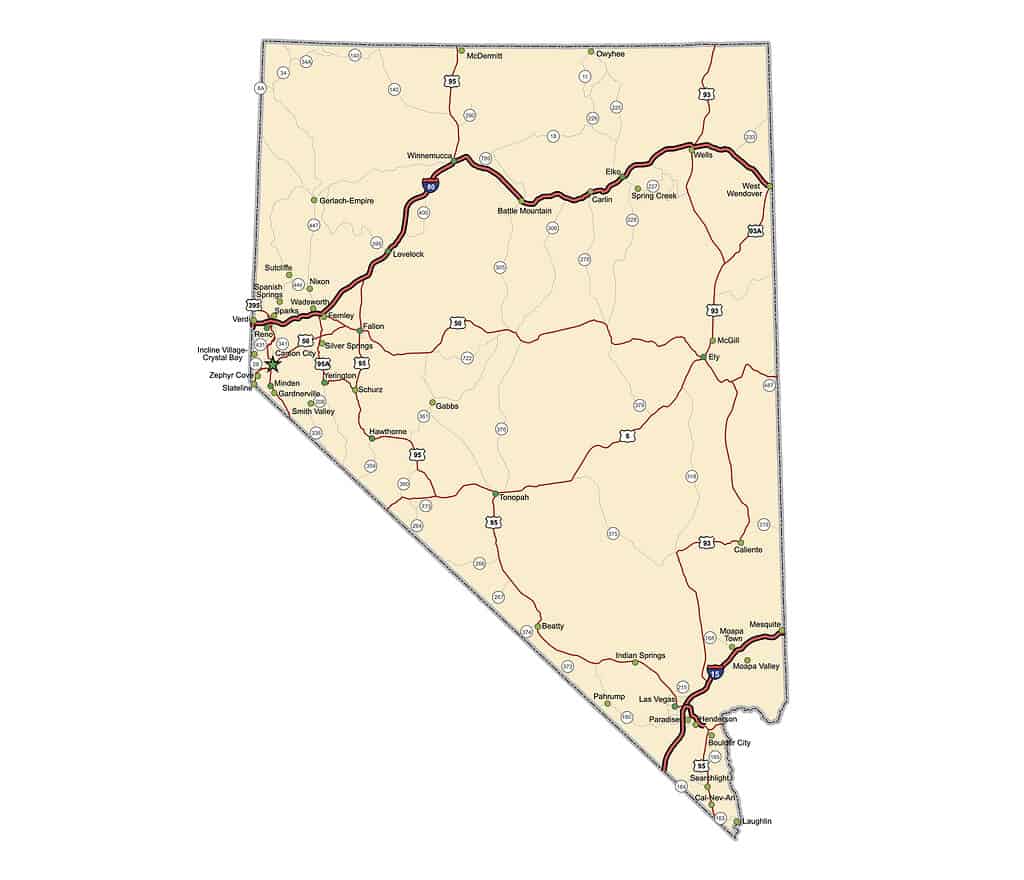
The width of the extreme southern tip of Nevada is measured in feet, not miles.
©iStock.com/jamirae
Square Miles and Kilometers
Nevada’s total area covers 110,577 square miles or 286,382 square kilometers. The state features just 791 square miles (2,048 square kilometers) of water, accounting for only 0.72% of its total area. Nevada’s land area measures 109,786 square miles (284,344 square kilometers).
Acres
There are 640 acres in a square mile. Nevada’s territory spans 70,769,280 acres.
To help visualize the size of an acre, it is roughly equivalent to a football field (minus the end zones). A professional soccer field is about 1.8 acres in size.
Other States
As noted at the beginning, Nevada is the seventh-largest state in the U.S. Only Alaska, Texas, California, Montana, New Mexico, and Arizona have larger footprints than Nevada.
Arizona is the state closest to the size of Nevada. It is 3,413 square miles (8,840 square kilometers) larger than Nevada.
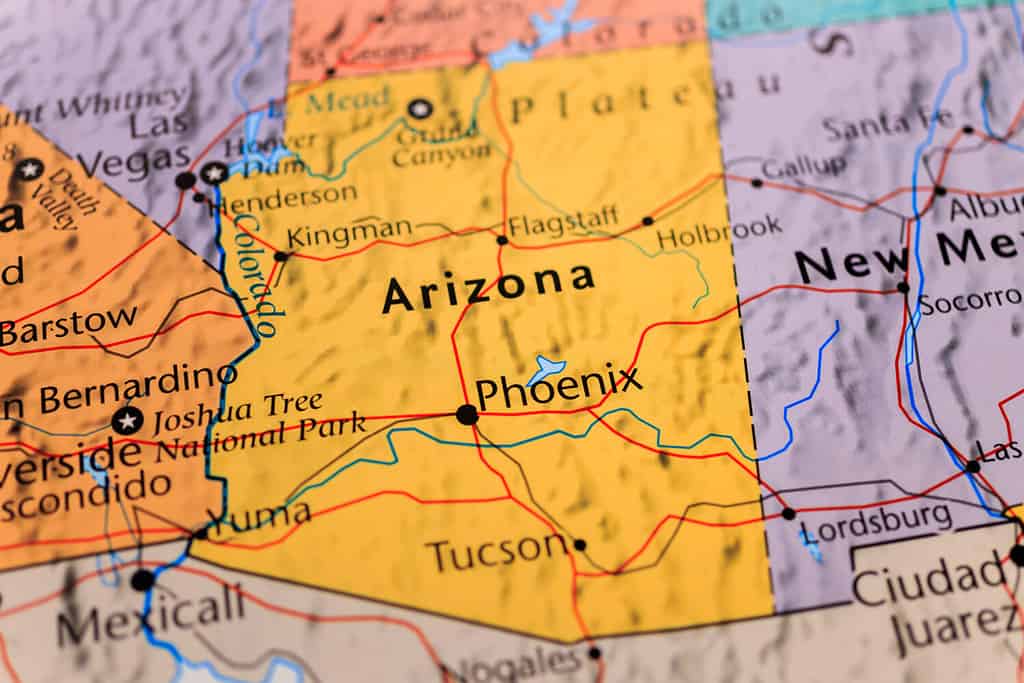
Arizona, Nevada’s neighbor to the southeast, is slightly larger than Nevada in terms of total area.
©Alexander Lukatskiy/Shutterstock.com
Alaska is the largest state in the U.S. by far. At 665,384 square miles (1,723,337 square kilometers), Alaska is more than six times the size of Nevada. Texas, the largest state in the contiguous U.S., is nearly twice as big as Nevada. California outsizes Nevada by almost one and a half times.
Rhode Island is the smallest state in the nation. Nevada is over 91 times larger than Rhode Island.
The combined states of West Virginia, Maryland, Hawaii, Massachusetts, Vermont, New Hampshire, New Jersey, Connecticut, Delaware, and Rhode Island could all fit inside Nevada’s borders. In fact, you could add another Maryland or twelve more Rhode Islands and still have room left over.
Nevada accounts for 2.91% of the total area of the United States. The six states that are larger than Nevada all account for three percent or more of the total U.S. area.
A miniscule 0.04% of U.S. land is contained in Rhode Island, while Alaska contains a whopping 17.48% of all United States land.
State Borders
Nevada shares borders with five states. It is bordered by Oregon to the northwest, Idaho to the northeast, Utah to the east, Arizona to the southeast, and California to the west.
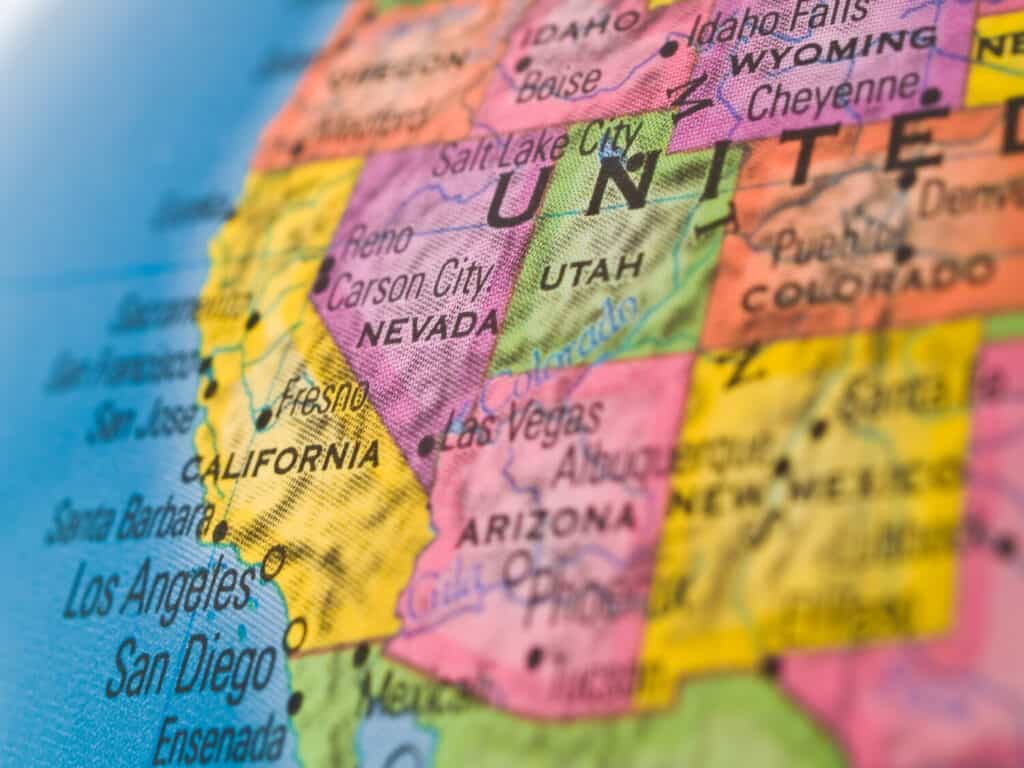
Nevada borders five states.
©235126/Shutterstock.com
Population
In 1940, Nevada was home to just 110,247 people, easily making it the least-populated state in the U.S. While it still ranks near the bottom third of U.S. states in terms of population, Nevada has seen an increase of nearly 2,800% since the 1940 census.
Nevada had a 2022 population of 3,177,772 (U.S. Census Bureau estimate), making it the 32nd most populous state in the nation. The state’s growth has been overwhelmingly due to residents who relocated to Nevada. In 2017, only twenty-six percent of Nevadans were born in the state, the lowest native resident percentage of any state in the U.S.
Nevada’s population is very similar to that of Iowa. The Hawkeye State had just 22,745 more residents than Nevada in 2022. The U.S. territory of Puerto Rico had around 44,000 more residents than Nevada in 2022.
Wyoming is the least populated state in the nation, with only 581,381 residents (2022 estimate). Nevada’s population is nearly five and a half times that of Wyoming.
The most populous state in the nation is California. The population of California is more than twelve times that of Nevada.
Population Density
Nevada’s expansive size and its relatively small population mean it has one of the lowest population densities in the nation. Population density is figured by the number of people per square mile of land area. Nevada has 28.3 people per square mile, making it the ninth least densely populated state in the country.
Idaho, Nevada’s neighbor to the north, has a lower population density of just 22.3 people per square mile, making it the seventh least densely populated state.
Alaska is the least densely populated state by far. There are only 1.3 people per square mile in this massive state.
The densest population of any state is found in New Jersey. The Garden State has 1,273 people per square mile.
The most densely populated place anywhere in the United States is Washington, D.C. The nation’s capital is packed with 11,295 people per square mile.
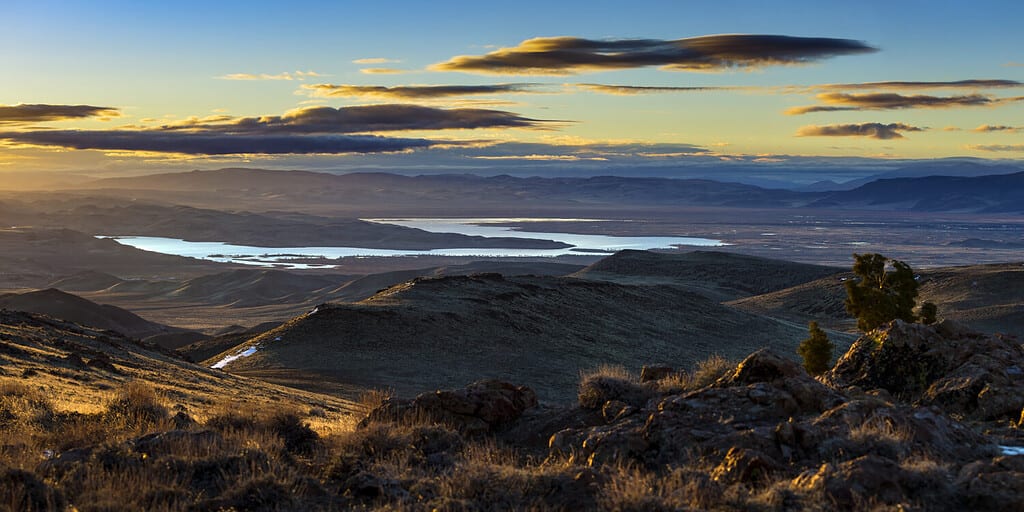
Huge swaths of Nevada have few, if any, residents.
©Neil Lockhart/Shutterstock.com
Largest Cities
There are five major cities (populations over 100,000) in Nevada.
Las Vegas is the state’s largest city by a wide margin. With over 641,900 residents, Las Vegas is more than twice the size of Nevada’s next largest city.
Henderson, which is less than a twenty-minute drive from Las Vegas, is Nevada’s second-largest city with around 317,600 residents.
Reno has a population of over 264,100, and North Las Vegas (which is less than three miles from Las Vegas) has around 262,500 residents.
The state’s smallest major city is Sparks, with nearly 108,500 residents.
Nevada’s capital, Carson City, has nearly 58,650 residents. With an elevation of 4,802 feet above sea level, it is the fourth-highest state capital in the nation. Only Denver (Colorado), Cheyenne (Wyoming), and Santa Fe (New Mexico) sit at higher elevations than Carson City.

Las Vegas is more than twice the size of Nevada’s next most-populated city.
©iStock.com/RandyAndy101
Counties
Nevada has sixteen counties, far below the average number of counties for a U.S. state (62). With so few counties in such a large state, many of Nevada’s counties are quite large.
Nye County in south-central Nevada spans a massive 18,147 square miles (47,001 square kilometers). This county is bigger than nine U.S. states! Almost fifteen Rhode Islands could fit inside Nye County.
Storey County in western Nevada is the state’s smallest county. It covers 264 square miles (684 square kilometers).
Carson City is an independent city, meaning it is not part of a county. Nevada’s capital is one of only two state capital cities that are also independent cities. Richmond, Virginia, is the other.
Clark County in southeastern Nevada is the state’s most populated county by far. The county’s 2022 population was 2,322,985. Clark County houses three of Nevada’s five largest cities (Las Vegas, Henderson, and North Las Vegas). Nearly three-quarters of Nevada’s residents live in this one county. Clark County is the sixth largest in the state in terms of area, spanning 7,911 square miles (20,489 square kilometers).
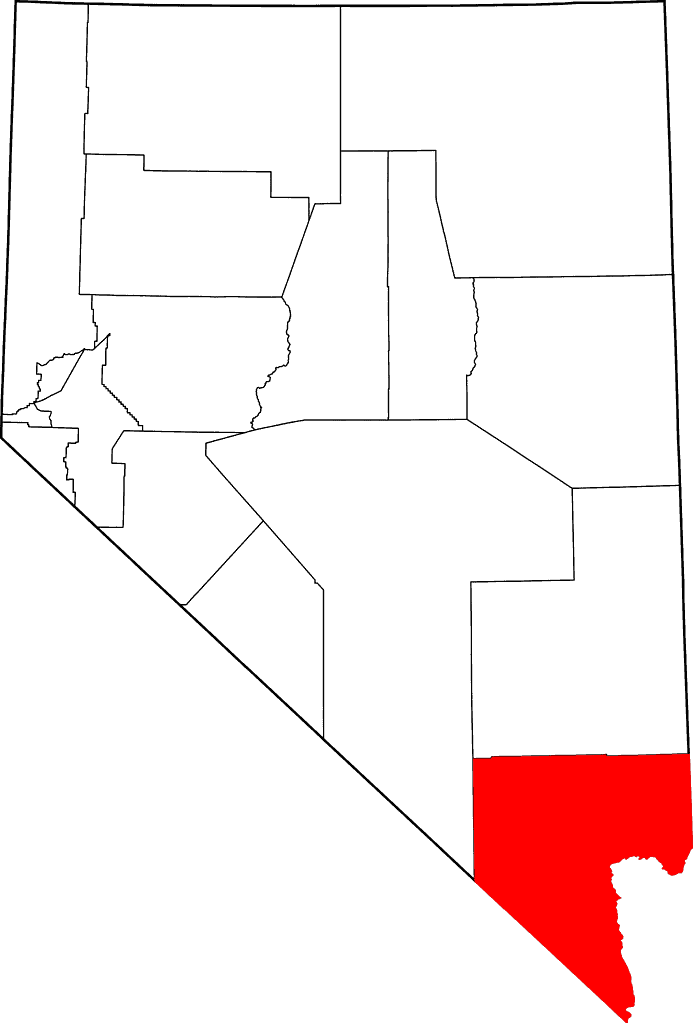
Almost three-fourths of all Nevadans live in Clark County.
©David Benbennick / Public domain – License
The least populous county in Nevada is Esmerelda County in southwestern Nevada. Only 744 people lived in the county in 2022. Esmerelda County is the thirteenth largest county in Nevada by area, covering 3,589 square miles (9,295 square kilometers). The county is dominated by mountains, including Boundary Peak. At 13,147 feet, this peak is the highest natural point in Nevada. A small portion of Death Valley National Park lies in the southeast corner of Esmerelda County.
Mountains
Nevada is perhaps best known for its desert landscapes, but mountains actually dominate much of the state. Nevada has over 2,100 named mountains, including 172 mountains with summits at or above 2,000 feet. While states like California and Colorado are probably more well-known for their mountains, Nevada has more peaks than either of those states. In fact, only Alaska has more mountains than Nevada.
Parks and More
Nevada is home to two national parks.
Death Valley National Park is the largest national park in the Lower 48 states. The park straddles the California-Nevada state line, but only about four percent of the park lies in Nevada. Death Valley is the biggest park in the Lower 48 states and the hottest and driest of all U.S. National Parks. It also has the lowest elevation of any national park.
Great Basin National Park lies solely in Nevada. The South Snake Mountains run through this park in the east-central part of the state. The park is also famous for its ancient bristlecone pine trees. The Lehman Caves allow guests to explore distinct limestone formations.
In addition to these two parks, Nevada is home to the Lake Mead National Recreation Area and Tule Springs Fossil Beds National Monument.
Along with the lands managed by the National Park Service, much of Nevada’s territory is owned by the U.S. Bureau of Land Management and other federal agencies. In total, nearly 80% of Nevada’s land is owned by the federal government. It is the highest percentage of federally-owned land of any state in the nation.

Great Basin National Park features bristlecone pine trees, the oldest non-clonal organisms on Earth.
©iStock.com/AvatarKnowmad
Rainfall
Nevada is the driest state in the U.S. The state averages just about seven inches of rainfall per year. The next driest states are neighboring Utah and Arizona. Precipitation is not uniform throughout Nevada, though. The northern and western parts of the state receive more rain than the southeast. Las Vegas is the second driest major city in the United States, trailing only Yuma, Arizona.
By contrast, Hawaii is the rainiest state in the nation, with over 63 inches of rain per year. Louisiana is the wettest state in the conterminous U.S., with around 60 inches of rain each year.
State Animals
Nevada has six official state animals. The desert bighorn sheep was named the official animal of Nevada in 1973.
The state’s other official animal representatives include the mountain bluebird (state bird), vivid dancer damselfly (state insect), Lahontan cutthroat trout (state fish), Ichthyosaur (state fossil), and desert tortoise (state reptile).

The desert bighorn sheep is Nevada’s state animal.
©twildlife/iStock via Getty Images
Pronunciation
No other state name is mispronounced more often than Nevada. People from outside the state often pronounce it “Ne-VAH-dah.” In this pronunciation, the “a” in the middle of the name sounds like the “a” in “father.”
Nevadans adamantly reject this pronunciation. Instead, the middle “a” is a short vowel sound, like the “a” in “apple.” The proper pronunciation can be heard in the video below.
The photo featured at the top of this post is © bubaone/ via Getty Images
Thank you for reading! Have some feedback for us? Contact the AZ Animals editorial team.






